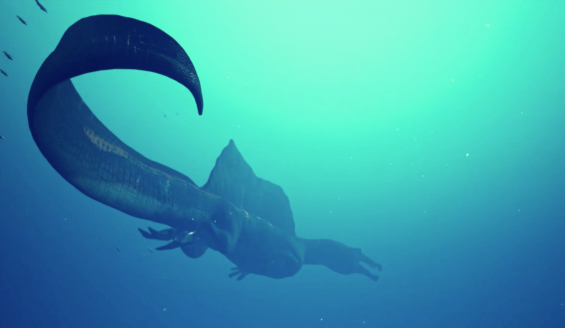Not all dinosaurs could swim, but the only one who could was living in Morocco around 66 million years ago. Said dinosaur is the Spinosaurus aegyptiacus, a theropod who lived in North Africa during the Cretaceous period.
Discovered in both Morocco and Egypt, scientists described this dinosaur as the largest carnivorous out there, who preyed mostly in the water and had round or crescent-like dorsal sails. However, when it was first discovered, the scientific community was not really convinced of its capacity to swim.
Thanks to fossils discovered in the Kem Kem beds, in eastern Morocco, a recent study has revealed that Spinosaurus was indeed a swimmer.
The study entitled «Tail-propelled aquatic locomotion in a theropod dinosaur» was published, Wednesday, on multidisciplinary science journal Nature.
Conducted by a group of international researchers, headed by Moroccan paleontologist at the University of Detroit Mercy Nizar Ibrahim, the study indicates that the dinosaur’s morphology is behind its aquatic abilities.
A swimming dinosaur
«It has recently been argued that at least some of the spinosaurids—an unusual group of large-bodied theropods of the Cretaceous era—were semi-aquatic, but this idea has been challenged on anatomical, biomechanical and taphonomic grounds, and remains controversial», the study recalled.
However, it explains that the studied fossils of Spinosaurus indicate it had a «tail with an unexpected and unique shape that consists of extremely tall neural spines and elongate chevrons, which forms a large, flexible fin-like organ capable of extensive lateral excursion».
The creature’s ability to adapt to an aquatic environment relied on the ovement of its tail’s shape. «The tail shape of Spinosaurus produces greater thrust and efficiency in water than the tail shapes of terrestrial dinosaurs and that these measures of performance are more comparable to those of extant aquatic vertebrates that use vertically expanded tails to generate forward propulsion while swimming», the study explained.
Commenting on the findings, Nizar Ibrahim told Live Science that «this discovery is the nail in the coffin for the idea that non-avian dinosaurs never invaded the aquatic realm».
«This dinosaur was actively pursuing prey in the water column, not just standing in shallow waters waiting for fish to swim by».
The conclusion reached by the recent study was somehow predictable. In 2014, the same researcher revealed that the same dinosaur could have been semi-aquatic.
«It’s the first dinosaur that shows these really incredible adaptations», Nizar Ibrahim said, commenting on a 2014 study he led. «There’s no doubt in my mind that Spinosaurus would have done most of its hunting in the water».
At the time, Nizar Ibrahim suggested that the dinosaur was only a semi-aquatic before, following further research, reaching the recent conclusions proving that the creature could indeed swim.





 chargement...
chargement...












